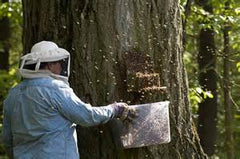Urban and Backyard Beekeeping
Urban and Backyard Beekeeping
Tweet


Beekeeping in urban areas and in your backyard has been a growing trend with gardeners. There are many benefits to keeping your own hive, which include increased pollination and harvesting honey. A beehive in your backyard will dramatically increase yields with more and larger fruits, vegetables, and flowers. A beehive on your property will greatly increase your success as a gardener. Bees also produce other products that can be harvested like beeswax, propolis, and royal jelly. Beekeeping has become more important in recent years due to the drastic decline of the wild bee population. There are many theories as to why this is happening, but the bottom line is that there are less wild bees in the environment. Keeping your own hive mitigates this problem, and provides you with a robust bee population right in your backyard. Many beekeepers also profess the therapeutic benefits of keeping a hive. Like gardening, beekeeping can be a relaxing and rewarding experience for the person tending to it. Your time and labor managing a hive will be well spent, especially when used in tandem with a garden.
There are a few things to consider when managing a hive in urban or neighborhood settings. There are some things that should be done to create a harmonious atmosphere that the bees will thrive in and remain calm and pleasant to live with. It is also important to review the local laws about beekeeping in your area, as some localities prohibit it. The following are some general tips for managing a hive on your property:
Fencing
A fence or shrubbery at least six feet high around the area of your hive will help keep the bees protected from wind and other disturbances, as well as keeping their flight path above people’s heads. Bees tend to fly in a straight path back to their hive, so placing it high above the ground with a high fence and shrubs around it will help keep their flight path away from people.
Water Source

Water is essential for all living things, and bees of course are no different. Make sure to leave a water source close to the hive, but not too close. Bees prefer to forage for water in ponds, creeks, puddles, and damp rocks and vegetation. Leave a barrel or pot filled with water, rocks, and some floating plants in it on your property. This will help ensure the bees don’t travel too far to get water, or go to your neighbor’s pool or pet’s water bowls.
Managing Swarms

It is in bees’ nature to swarm, and there is no fail-proof way to totally prevent swarming. However, swarming can be successfully managed if certain techniques are properly employed. There are many different ways to manage a hive to control swarming, so research into these methods should be undertaken. Controlling swarming is very important for urban and backyard beekeeping. Most swarming is linked to the Queen’s activity and egg laying, in addition to searching for a new hive. Setting up “bait hives” on your property before a swarm is a good way to ensure the bees find a new home without leaving your yard.
Managing the Hive


When working and tending to the hive, the beekeeper should make sure that they do so under the proper conditions. This will decrease the chances of the bees becoming agitated. Good conditions for working with the hive include:
- Keeping the hive in an area that gets plenty of sun, but make sure it does not get too hot
- Keeping the hive in a place with protection from winds
- Working when most of the bees are out collecting nectar
- Selecting a place that has an abundant nectar flow from flowering plants
- Working when the temperature is not too hot outside
- Working when the bees are not agitated by predators, moving people or objects, and lawn care equipment like mowers, leaf blowers, weed-whackers etc.
- Smoking the bees is crucial for calming them before they are moved or when disturbing the hive.
The following link is a great resource for learning more about urban and backyard beekeeping:

